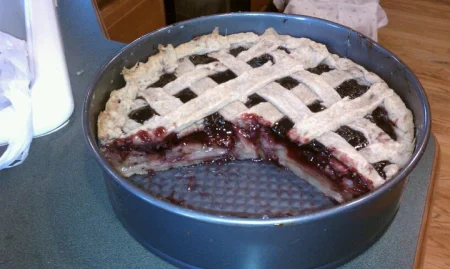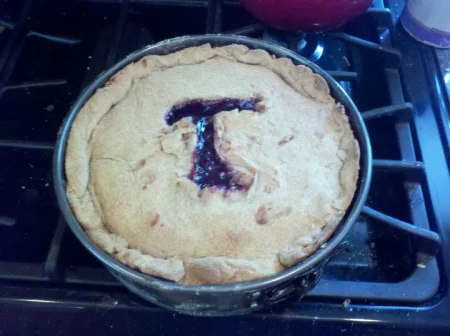One week after Tau Day 2011 has come and gone, I thought a few things that came up in comment threads deserved a little more attention.
1. τ-doku
I mentioned the possibility of tau-themed sudoku. Thanks to juanmah, I know that at least one such exists, and here it is. Kudos to the puzzle creator and thanks for the link. I’ve solved that puzzle, so I know that it works. It’s quite easy, so you could give it even to sudoku novices to promote Tau Day. One quirk of the linked puzzle is that it uses two colors so that the repeated digits in 6.2831853 can count as distinct symbols.
I wondered whether a more interesting puzzle could be found by not distinguishing the 8s and 3s. What follows is my take on that idea. I offer for your consideration my first ever sudoku puzzle.
(Edit: I mistyped one of the givens when I first posted this. This is corrected now. The 1 in row six was incorrectly given as a dot. My apologies for any frustration this may have caused anyone.)
The central row emphasis is purely decorative. Note that, unlike the sudoku linked to above, the 3 and 8 are not distinguished by color here; this is a sudoku puzzle with only seven symbols. Each row, column, and block will have two 3s and two 8s (and one each of the other five symbols).
Near the end of the construction process, I was forced to sacrifice some of the difficulty level that I wanted in order to maintain symmetry of the givens. I’m not happy about that, but I don’t think it turned out too easy to be interesting. As I said, it was my first try at sudoku construction, but it won’t be my last.
2. τ as a natural period
We casually call tau the circle constant, but let’s not forget that its ubiquity extends well beyond geometry (would it really be ubiquity otherwise?). Here’s a simple demonstration of that. In the comment thread I formulated this in terms of differential equations, but here let me be more casual.
Imagine two particles (infinitesimal bugs, if you like) on the number line, call them Alice and Bob. Their starting positions can be anywhere (but let’s avoid the trivial case where both bugs start at 0; having one but not the other start at 0 is fine). Then the bugs start moving. At any point in time, Alice’s velocity is given by Bob’s position, and Bob’s velocity is the negative of Alice’s position (imagine that they continuously look at each other to decide how to move). Quite a simple dynamical system, but if you actually simulate it, you’ll see something potentially unexpected. The bugs may wander far from where they started, but they always come back; indeed, they will always both come back to their starting position at exactly the same moment, and then the cycle will repeat. How long will it take for this repetition to occur , that is, what is the period of the motion? No matter where you start the bugs, the period is always exactly τ time units.
Why is this happening? Because the problem setup encodes the differential equation , whose solutions are linear combinations of sine and cosine (in natural units), which are both periodic with period τ.
3. Is τ the right symbol?
Xamuel (whose blog is excellent, by the way) called into question the symbol choice, on the grounds that pi has two legs while tau has only one. Since the circle constant is twice pi and not the other way around, what we should want is a symbol with four legs, the argument goes. This made me smile, because it was the very same objection that occured to me when I first watched Vi Hart’s anti-pi video, and I even emailed her to that effect. However, in the course of writing that email, I realized the natural counter. Read the legs as Roman numerals. Pi parses as “horizontal squiggle over two” while tau parses as “horizontal squiggle over one”. Quite consistent with our usage.
(On a less whimsical note, τ is a good choice because it stands for turn; a right angle measures because it is a quarter-turn.)




 Posted by Cap Khoury
Posted by Cap Khoury 

